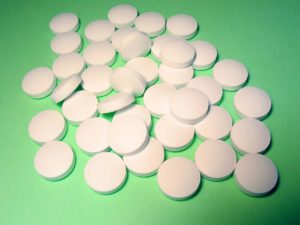 A recent review of studies looked at whether cranberry juice helps with urinary tract infections (UTIs) and the results were encouraging. Yes, cranberry juice or cranberry tablets help in preventing UTIs.
A recent review of studies looked at whether cranberry juice helps with urinary tract infections (UTIs) and the results were encouraging. Yes, cranberry juice or cranberry tablets help in preventing UTIs.
Twenty well-done studies were reviewed. Drinking cranberry juice or taking a cranberry tablet resulted in a 27 to 54% lower rate of UTIs (the numbers varied between studies), and a 49% to 59% lower rate of antibiotic use. Cranberry compounds reduced the prevalence of UTI symptoms. These are great results!
The majority of women suffer from a UTI at some point in their life, and some women suffer frequently - many times a year. Antibiotics have long been the treatment of choice, but antibiotic resistance is increasing, so finding something that prevents UTIs is important.
By the way, cranberries and cranberry juice has been promoted for decades as both UTI prevention and treatment. [Other treatment possibilities for treatment and prevention are: D-mannose, drinking more water, the probiotic L. crispatus, and an oral vaccine.]
From Medscape: It's in the Juice: Cranberries for UTI Prevention
A systematic review and network meta-analysis found cranberry juice can help prevent urinary tract infections (UTIs). ...continue reading "Cranberry Juice Helps Prevent Urinary Tract Infections"

 Eating plant-based foods has health benefits. But only if it's from real foods, and not ultra-processed. A recent
Eating plant-based foods has health benefits. But only if it's from real foods, and not ultra-processed. A recent  The microbes living on and in us (the human microbiome or microbiota) play a big role in our health. Certain microbes are even implicated in cancer development and progression. Thus, it shouldn't come as a surprise that new
The microbes living on and in us (the human microbiome or microbiota) play a big role in our health. Certain microbes are even implicated in cancer development and progression. Thus, it shouldn't come as a surprise that new  There has been a lot of discussion recently over whether or when the Atlantic Ocean current called Atlantic Meridional Overturning Current (AMOC) could collapse soon. The Gulf Stream is part of this current. This critically important current acts like a conveyor belt that brings warm water through the Atlantic Ocean up to the north Atlantic (Europe) and colder, saltier water down to the Southern Hemisphere.
There has been a lot of discussion recently over whether or when the Atlantic Ocean current called Atlantic Meridional Overturning Current (AMOC) could collapse soon. The Gulf Stream is part of this current. This critically important current acts like a conveyor belt that brings warm water through the Atlantic Ocean up to the north Atlantic (Europe) and colder, saltier water down to the Southern Hemisphere. We've known for a while that the head trauma from playing football can lead to the degenerative brain disease chronic traumatic encephalopathy (CTE). Now it turns out that some (many?) US Navy SEALS also have an unusual pattern of brain damage. It is traumatic brain injury due to repeatedly being exposed to blast waves, which occur from firing their own weapons or enemy action.
We've known for a while that the head trauma from playing football can lead to the degenerative brain disease chronic traumatic encephalopathy (CTE). Now it turns out that some (many?) US Navy SEALS also have an unusual pattern of brain damage. It is traumatic brain injury due to repeatedly being exposed to blast waves, which occur from firing their own weapons or enemy action. The incidence of both intestinal bowel diseases (IBD) and colorectal cancer is rapidly increasing in developed countries (e.g., US, Canada, Europe). There are many theories over why this is occurring, with most researchers thinking a person's diet plays a role. A big suspect in promoting IBD and colorectal cancer is the Western diet, which has lots of ultra-processed foods and is also low in fiber.
The incidence of both intestinal bowel diseases (IBD) and colorectal cancer is rapidly increasing in developed countries (e.g., US, Canada, Europe). There are many theories over why this is occurring, with most researchers thinking a person's diet plays a role. A big suspect in promoting IBD and colorectal cancer is the Western diet, which has lots of ultra-processed foods and is also low in fiber. Bottom line:
Bottom line:
 Studies on aspirin keep coming. For decades, studies found that persons taking aspirin frequently have a lowered risk of developing colorectal (colon) cancer, and that they are less likely to die if they do develop colorectal cancer. A recent
Studies on aspirin keep coming. For decades, studies found that persons taking aspirin frequently have a lowered risk of developing colorectal (colon) cancer, and that they are less likely to die if they do develop colorectal cancer. A recent  This year a number of persons reported to me that when their neighbors started with mosquito and tick control pesticide applications, they no longer have bees or butterflies in their yards. Even if they have lots of bee and butterfly friendly flowers, or lots of clover - they now rarely or never see bees and butterflies. This has also been my experience.
This year a number of persons reported to me that when their neighbors started with mosquito and tick control pesticide applications, they no longer have bees or butterflies in their yards. Even if they have lots of bee and butterfly friendly flowers, or lots of clover - they now rarely or never see bees and butterflies. This has also been my experience. Bees are pollinators
Bees are pollinators